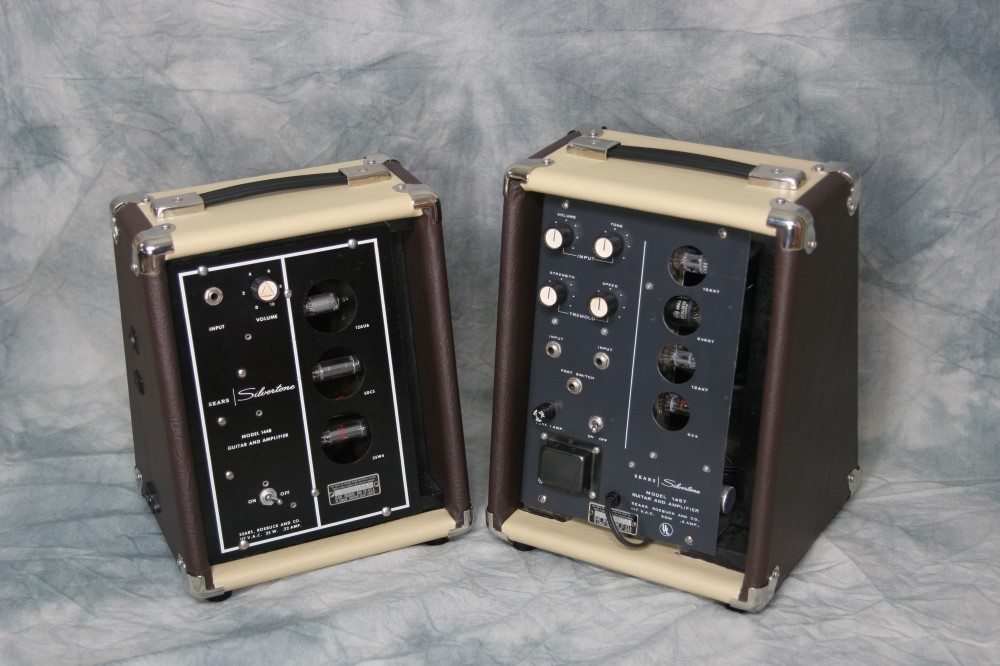Mosrite Bass (8/10)
Mar 15, 2019

This stayed more pebbly than I expected. I think I will let it harden-off for a week and then try to smooth down the sides. I don't believe the 24-hour cure time anymore, nothing about this subject has turned out to be true. I'll leave the back, it looks like it will stand up pretty well to buckle rash.
I wouldn't be unhappy at all with this finish on a garage door. This stuff is basically just house paint, minus the pigment and plasticisers. If you want to use house paint on your guitar, go right ahead. I'm sure better results than this can be achieved. I just don't think it is worth the effort when clearly superior oil-based poly is cheaper and easier.
Yellowing has been part of luthiery since the middle ages. Most of Fender's classic colors are actually the result of yellowing over the original color. If I want a non-yellowing clear-coat, there are alternatives to water-based, although my experience with that so far is that they are very brittle and fragile.
Mar 17, 2019
Pressing on With the Water-based Mistake
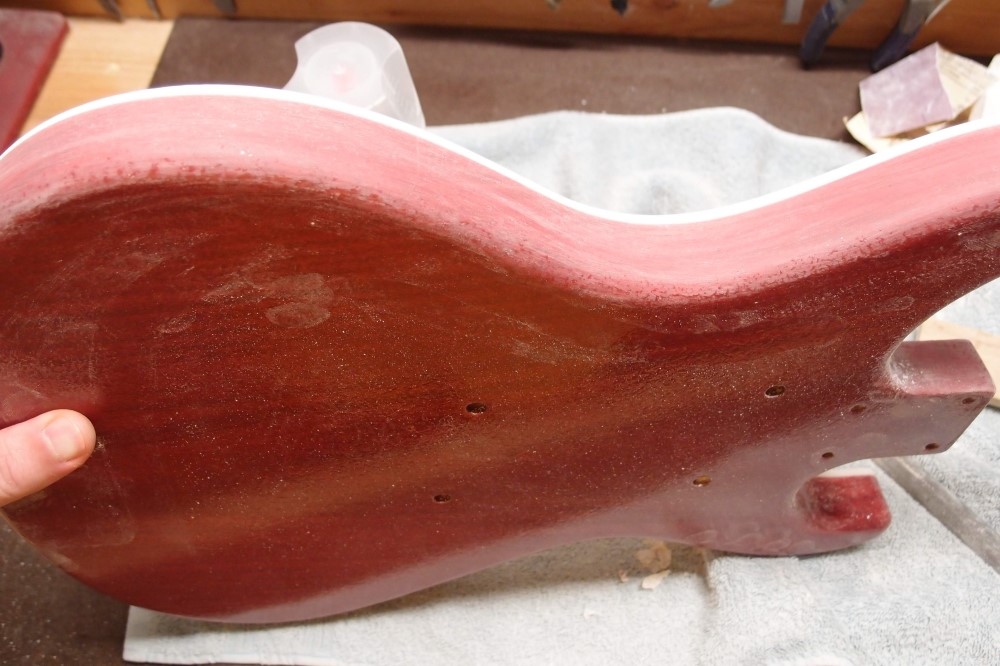
I started smoothing down the sides on my poor water-based victim, and it is going very well. I've done the entire lower half with just fingers, and my hand needs a rest.
Again, the water-based poly dry-sands very nicely, like spackle. No loading of the paper, or even dulling. My goal is to transition from a polish at the binding to full orange-peel at the back, where I will just knock the tops off. Even on the sides, I am leaving little shiny dimples as depth markers. Less obvious and more difficult spots -- basically everything between the tips of the horns -- are getting less treatment.
My comparison to spackle is worrisome. Judging from the way it sands, this finish is quite hard, but not very strong or resilient. In fact, I'll bet it's pretty brittle, like many clear finishes, especially acrylics. Which, for all I know, this is. I wonder what happens the first time you drop it on a wood floor? One of you water-based aficionados, please test this and report the results. My guess is it shatters. On the plus side, it does seem to take a good polish. Time will tell if it holds it. I really just want to get this build over with, it has stopped being fun.
Yesterday's two Krylon poly'd bodies look terrific. In a few days, I can smooth them over, and then apply the finish coats on the next day that the weather cooperates. So easy. And cheap - 3 cans, $15 for two bodies. Even with the two offset strap buttons, they sit perfectly well on my painting stand. The single piece of Dollar Store double-sided tape holding the battery box is totally unfazed by being sprayed with all kinds of nasty chemicals.
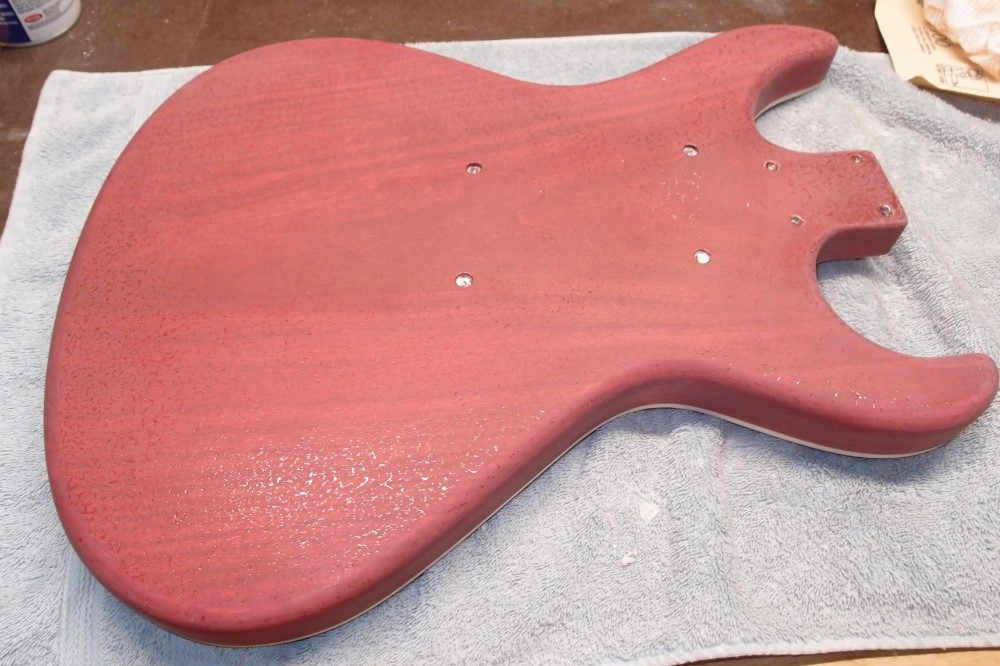
There, the whole back and sides are done. The sides are almost totally smoothed, and the back is a lot smoother than I intended, Rather than an $800 Gibson finish, this will be more like a $1200 Gibson finish. In fact, after I run up through the grits and then polish it, this might end up being a $2000 Gibson finish. By accident. I actually intend to leave the back a little rough, so any small flaws and future damage will blend in. The $1200 finish is what I'm shooting for now.
I also filed the inside of the neck pocket smooth and flat and cleaned out the corners. The water-based 'poly' displayed very poor adhesion when I started chipping at it with the corners of the file. It popped right out in big flakes. Nothing like real polyurethane.
I wiped this body down with a dry rag for the picture, as I haven't found a liquid that is safe on this water-based "poly". Alcohol and naphtha have both proved damaging, not to mention the fumes. I can't imagine anything stronger would be safe, and I don't want to tempt fate with water.
The binding did stay nice and white, and the body red. If this was oil-based poly, they would be more like yellow and orange by now. The scary thing is, I did this entire job with one quarter-sheet of 320 that wasn't new, and it is still cutting like when I started. It was too easy. Just how worthless is this water-based "polyurethane"? How long will this finish hold up?
I'm afraid to do any more now, I am going to hang this up for a week, maybe it will toughen-up. Water-based "polyurethane" appears to be a protective finish that needs a protective finish. I am afraid it turns out to be shiny and worthless. On the other hand, if I was building for money, this might be a good way to push product out the door fast and get paid - nitrocellulose all over again.
BTW, that red red color is a Varathane stain from Home Depot. Varathane stains need to be cut 50% with mineral spirits to get a transparent finish. At full strength, they are basically paint. Varathane products are pretty sketchy.
Water-based "Polyurethane" - Final Verdict
I just took a close look at the front of the water-based "poly" finish, which I had done an initial polish on a few days ago. I was absolutely shocked to find that the wood grain is already pulling through the finish. The original undercoat is well over a month old. So much for fast-curing - there is no way this should be happening.
In my experience, everything said about this stuff is a lie. All of it.
Water-based polyurethane is total utter garbage.
Mar 31, 2019
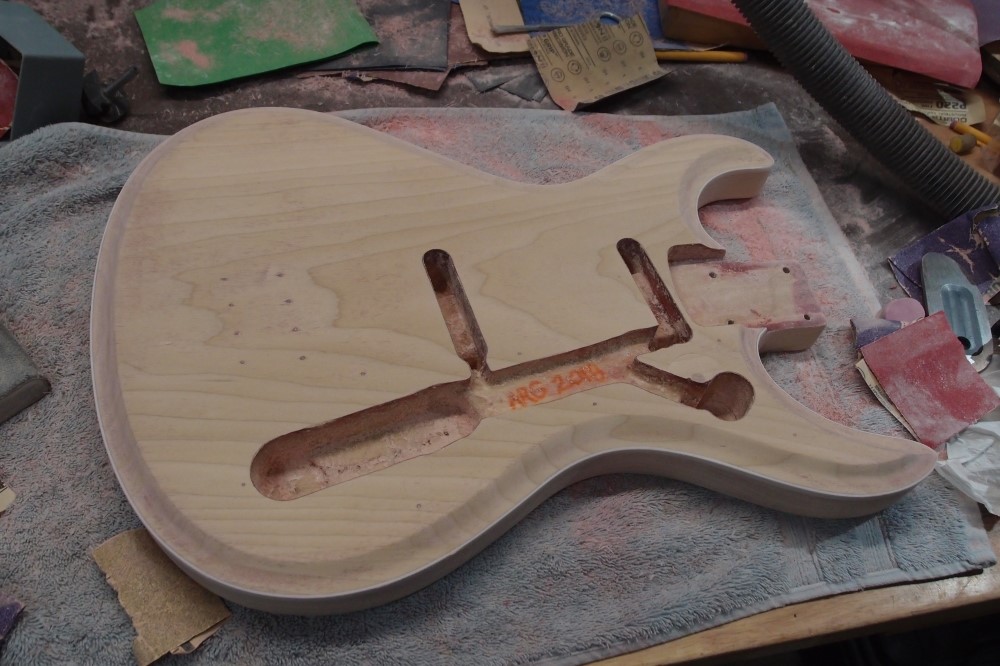
The long water-based nightmare is over. I tried to get a decent polish on the water-based polyurethane and found that I was simply not going to get the results that I expect, the results that I routinely get with oil-based poly. So I sanded it all off so I can start over with stain and then a real finish.
Apr 1, 2019
Cleaned up yesterday's mess - and what a mess - a whole body's-worth of dust. The poplar actually looks good. I wiped it down with water to raise the grain for final finish sanding to 220. Poplar really needs that, now it feels like it hasn't been sanded at all.
Considering how much this piece has been messed around, it is still in pretty good shape. The German carve is now somewhat gentler. The binding also made it through, although it is noticeably smaller than a raw piece. On the plus side, it's really smooth now.
Apr 4, 2019
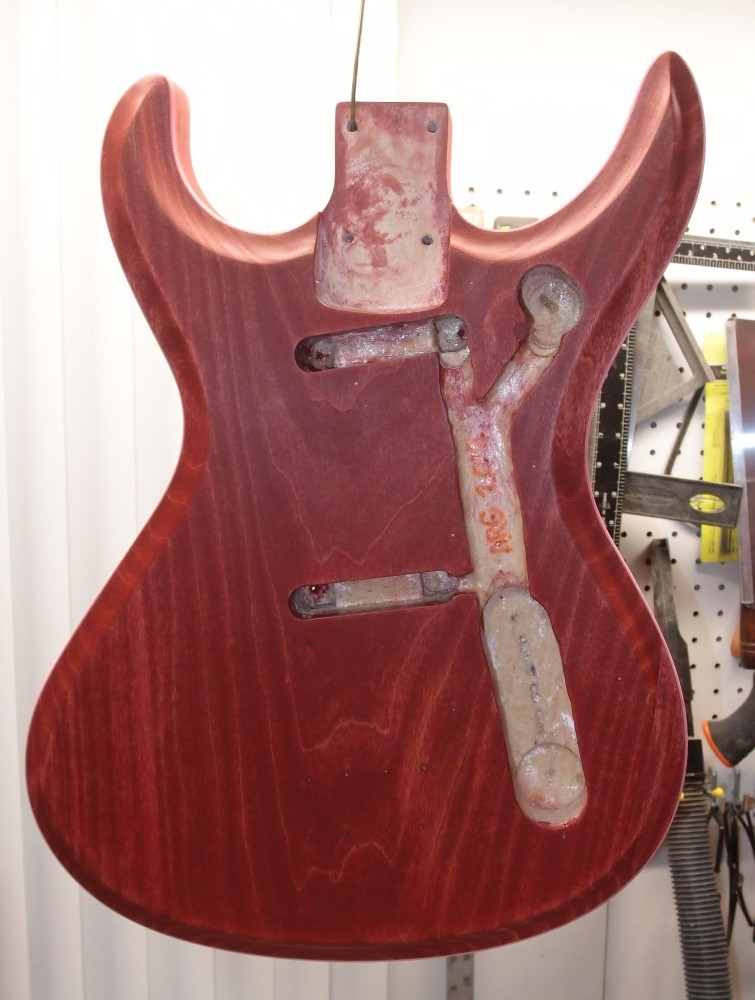
Almost back to where I was before the water-based polyurethane disaster. I knocked the grain down with 220, then made a 3:1 mix of mineral spirits and stain. I applied that until I ran out, the wood really drank it in. I'll let this dry overnight, and see how it looks in the morning.
Poplar is well-known for staining very badly - all blotches, but with the stain diluted down to a wash, it went on very evenly and left the grain nicely highlighted. This Varathane stain would otherwise go on almost like paint, and basically obliterate the wood grain.
Apr 5, 2019

As often happens, staining revealed where I hadn't sanded enough; in this case, all around the sides. Getting all the water-based crud off was an industrial job involving belt sanders, and even the router to clean off the back edge. I went over the edges by hand with 220, avoiding the binding, since I don't want to thin that down too much. Then I mixed up a new batch of thinned stain and re-stained. Looks good.
I fully expect to salvage this piece. After this, I have no more thick poplar blanks and no plans for more, although I can easily get them from the local lumberyard. I do have some nice 3/4" poplar for an experiment I have in mind someday.











